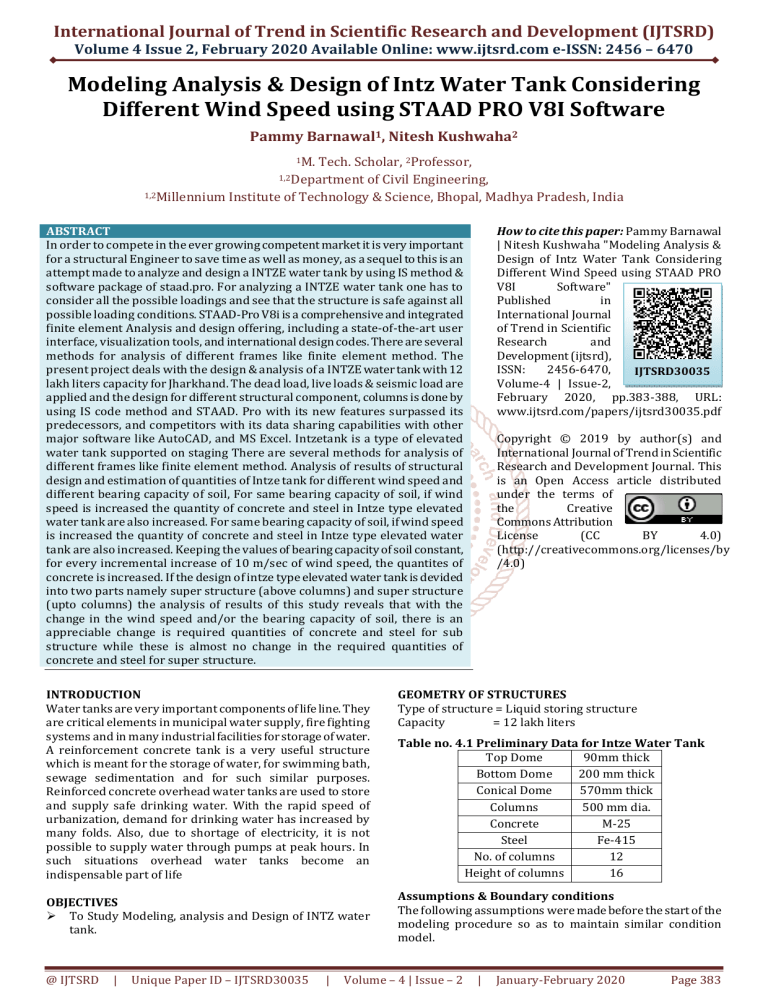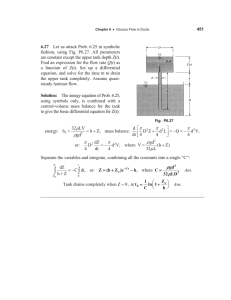
International Journal of Trend in Scientific Research and Development (IJTSRD)
Volume 4 Issue 2, February 2020 Available Online: www.ijtsrd.com e-ISSN: 2456 – 6470
Modeling Analysis & Design of Intz Water Tank Considering
Different Wind Speed using STAAD PRO V8I Software
Pammy Barnawal1, Nitesh Kushwaha2
1M.
Tech. Scholar, 2Professor,
1,2Department of Civil Engineering,
1,2Millennium Institute of Technology & Science, Bhopal, Madhya Pradesh, India
How to cite this paper: Pammy Barnawal
| Nitesh Kushwaha "Modeling Analysis &
Design of Intz Water Tank Considering
Different Wind Speed using STAAD PRO
V8I
Software"
Published
in
International Journal
of Trend in Scientific
Research
and
Development (ijtsrd),
ISSN:
2456-6470,
IJTSRD30035
Volume-4 | Issue-2,
February 2020, pp.383-388, URL:
www.ijtsrd.com/papers/ijtsrd30035.pdf
ABSTRACT
In order to compete in the ever growing competent market it is very important
for a structural Engineer to save time as well as money, as a sequel to this is an
attempt made to analyze and design a INTZE water tank by using IS method &
software package of staad.pro. For analyzing a INTZE water tank one has to
consider all the possible loadings and see that the structure is safe against all
possible loading conditions. STAAD-Pro V8i is a comprehensive and integrated
finite element Analysis and design offering, including a state-of-the-art user
interface, visualization tools, and international design codes. There are several
methods for analysis of different frames like finite element method. The
present project deals with the design & analysis of a INTZE water tank with 12
lakh liters capacity for Jharkhand. The dead load, live loads & seismic load are
applied and the design for different structural component, columns is done by
using IS code method and STAAD. Pro with its new features surpassed its
predecessors, and competitors with its data sharing capabilities with other
major software like AutoCAD, and MS Excel. Intzetank is a type of elevated
water tank supported on staging There are several methods for analysis of
different frames like finite element method. Analysis of results of structural
design and estimation of quantities of Intze tank for different wind speed and
different bearing capacity of soil, For same bearing capacity of soil, if wind
speed is increased the quantity of concrete and steel in Intze type elevated
water tank are also increased. For same bearing capacity of soil, if wind speed
is increased the quantity of concrete and steel in Intze type elevated water
tank are also increased. Keeping the values of bearing capacity of soil constant,
for every incremental increase of 10 m/sec of wind speed, the quantites of
concrete is increased. If the design of intze type elevated water tank is devided
into two parts namely super structure (above columns) and super structure
(upto columns) the analysis of results of this study reveals that with the
change in the wind speed and/or the bearing capacity of soil, there is an
appreciable change is required quantities of concrete and steel for sub
structure while these is almost no change in the required quantities of
concrete and steel for super structure.
Copyright © 2019 by author(s) and
International Journal of Trend in Scientific
Research and Development Journal. This
is an Open Access article distributed
under the terms of
the
Creative
Commons Attribution
License
(CC
BY
4.0)
(http://creativecommons.org/licenses/by
/4.0)
INTRODUCTION
Water tanks are very important components of life line. They
are critical elements in municipal water supply, fire fighting
systems and in many industrial facilities for storage of water.
A reinforcement concrete tank is a very useful structure
which is meant for the storage of water, for swimming bath,
sewage sedimentation and for such similar purposes.
Reinforced concrete overhead water tanks are used to store
and supply safe drinking water. With the rapid speed of
urbanization, demand for drinking water has increased by
many folds. Also, due to shortage of electricity, it is not
possible to supply water through pumps at peak hours. In
such situations overhead water tanks become an
indispensable part of life
GEOMETRY OF STRUCTURES
Type of structure = Liquid storing structure
Capacity
= 12 lakh liters
OBJECTIVES
To Study Modeling, analysis and Design of INTZ water
tank.
Assumptions & Boundary conditions
The following assumptions were made before the start of the
modeling procedure so as to maintain similar condition
model.
@ IJTSRD
|
Unique Paper ID – IJTSRD30035
|
Table no. 4.1 Preliminary Data for Intze Water Tank
Top Dome
90mm thick
Bottom Dome
200 mm thick
Conical Dome
570mm thick
Columns
500 mm dia.
Concrete
M-25
Steel
Fe-415
No. of columns
12
Height of columns
16
Volume – 4 | Issue – 2
|
January-February 2020
Page 383
International Journal of Trend in Scientific Research and Development (IJTSRD) @ www.ijtsrd.com eISSN: 2456-6470
Only the main block of the water tank is considered for
analysis. The staircases are not considered in the design
procedure.
Capacity of the water tank is considered 1200000 L.
Cylindrical Wall of 330 mm thick with 15 mm plaster on
each side will be considered for storage of water. Height
of the freeboard is 420 mm provided
The bottom slab is 200 mm thick and Conical Dome is
570mm thick.
For all structural elements, grade of concrete is taken M25 &and grade of steel is taken Fe-415.
The footings are not designed. And supports are
assigned in the form of fixed supports.
Seismic loads zone 3 are considered in the horizontal
direction only and the vertical direction are assumed to
be insignificant.
Sizes of the members are as follows: (All dimensions are
in mm)
Figure 4.2: Model of Intze Water Tank
Figure 4.3:3-D Model of Intze Water Tank
@ IJTSRD
|
Unique Paper ID – IJTSRD30035
|
Volume – 4 | Issue – 2
|
January-February 2020
Page 384
International Journal of Trend in Scientific Research and Development (IJTSRD) @ www.ijtsrd.com eISSN: 2456-6470
ANALYSIS AND DESIGN BY MANUAL METHODDESIGN OF INTZE TANK (CAPACITY 1200000 LITERS)
TABLE 4.1 DATA OF INTZE TANK
Capacity of tank
1.2 million lit. (i.e. 1200m3)
Height of Supporting Tower
16m
Number of Column
12nos.
Practices Area
JHARKHAND
Material
M25 concrete & Fe415 steel
RESULTS
RELATION BETWEEN WIND SPEED, VOLUME OF STEEL AND VOLUME OF CONCRETE (BEARING CAPACITY 10 t/m2):-
Fig. 5.1 Wind speed & Volume of Concrete
Fig. 5.2 Wind speed & Volume of steel
Fig. 5.3 Wind speed & Volume of Concrete
@ IJTSRD
|
Unique Paper ID – IJTSRD30035
|
Volume – 4 | Issue – 2
|
January-February 2020
Page 385
International Journal of Trend in Scientific Research and Development (IJTSRD) @ www.ijtsrd.com eISSN: 2456-6470
Fig.5.4 Wind speed & Volume of steel
Fig. 5.5 Wind speed & Volume of Concrete
Fig. 5.6 Wind speed & Volume of steel
Fig.5.7 Wind speed & Volume of Concrete
@ IJTSRD
|
Unique Paper ID – IJTSRD30035
|
Volume – 4 | Issue – 2
|
January-February 2020
Page 386
International Journal of Trend in Scientific Research and Development (IJTSRD) @ www.ijtsrd.com eISSN: 2456-6470
Fig.5.8 Wind speed & Volume of steel
Fig. 5.9 Wind speed & Volume of Concrete
Fig.5.10 Wind speed & Volume of steel
Fig.5.11 Combined graph of bearing capacity of soil, volume of concrete and wind speed
@ IJTSRD
|
Unique Paper ID – IJTSRD30035
|
Volume – 4 | Issue – 2
|
January-February 2020
Page 387
International Journal of Trend in Scientific Research and Development (IJTSRD) @ www.ijtsrd.com eISSN: 2456-6470
Fig. 5.12 Combined graph of bearing capacity of soil, quantity of steel and wind speed
CONCLUSIONS
Analysis of results of structural design and estimation of
quantities of Intze tank for different wind speed and
different bearing capacity of soil the following conclusion are
drawn: 1. For same bearing capacity of soil, if wind speed 10m/sec
is increased the quantity of concrete and steel in Intze
type elevated water tank are also increased.
2. Keeping the values of bearing capacity of soil constant,
for every incremental increase of 10 m/sec of wind
speed, the quantites of concrete is increased.
3. For every incremental increase of 10 m/s of wind speed,
the increase of quantity of concrete is more than the
quanity of steel.
4. For the same wind speed, if the baring capacity of soil is
increased, the quantities of concrete and steel are
decreased.
5. If the design of intze type elevated water tank is devided
into two parts namely super structure (above columns)
and super structure (upto columns) the analysis of
results of this study reveals that with the change in the
wind speed and/or the bearing capacity of soil, there is
an appreciable change is required quantities of concrete
and steel for sub structure while these is almost no
change in the required quantities of concrete and steel
for super structure.
[5] Meen-Wah Gui and Balasingam Muhuthan, (2006),
“Bearing Capacity of Foundations on Sand Using The
Method of Slip Line”, Journal of Marine Science and
Technology, Vol. 14, No. 1, pp. 1 – 14.
[6] N. Krishna Raju, “Advanced Reinforced Design” CBS
Publishers and Distributers, New Delhi.
[7] R. Livaoglu, A. Dogangin, “An investigation about
effects of supporting systems on fluid-elevated tanks
interaction”, First International conference on
Seismology
&
Earthquake
Engineering
(SEE),Turkey,May-07.
[8] Rai, D. C., (2003), “Performance of Elevated Tanks in
Mw 7.7 Bhuj Earthquake”, Indian Acad. Sci. (Earth
Planet. Sci.).
[9] S. Ramamrutham and R. Narayan “Design of reinforced
Concrete Structure” Dhanpat Rai Publishing Company
(P) LTD, New Delhi PVT. LTD.
[10] Sanjay P. Joshi, (2000) ”Equivalent Mechanical Model
For Horizontal Vibration Of Rigid Intze Tank”, ISET
Journal of Earthquake Technology, Technical Note, Vol.
37, No. 1 – 3, March – Sept. 2000, pp. 39 - 47
[11] Sayal & Goel .Reinforced Concrete Structures. New
Delhi. S Chand publication.2004.
REFERENCES
[1] Asari Falguni, Prof. M. G. Vanza,(2012), “Structural
control system for Elevated water tank”, International
Journal of Advanced engineering research and studies,
IJAERS/Vol-I/April-June,2012.
[12] Soheil Soroushnia, Sh. Tavousi Tafreshi, F. Omidinasab,
N. Beheshtian, Sajad Soroushnia, “Seismic Performance
of RC Elevated Water Tanks with Frame Staging and
Exhibition Damage Pattern”, The Twelfth East AsiaPacific Conference on Structural Engineering and
Construction (2011).
[2] Ayazhussain M. Jabar & H. S. Patel,(2012), “Seismic
behavior of RC elevated water tank under different
staging pattern and earthquake characteristics”,
International journal of advanced engineering research
and studies, IJAERS/Vol-I,April-June,2012.
[13] Suchita Hirde Dr., Ms. Asmita Bajare, Dr. Manoj Hedaoo,
“Seismic performance of elevated water tanks”,
International Journal of Advanced Engineering
Research and Studies (2011).
[3] B. C. Punmia, A. K. Jain, and A.K. Jain, (2001) “R.C.C.
Design”, Laxmi Publications (P) LTD, New Delhi.
[14] V. K. Puri, (2008) “Foundation for Dynamic Load”
Geotechnical Earthquake Engineering and Soil
Dyanmics IV, CD-ROM, May 18-22, Sacramento, CA.
[4] Manish N. Gandhi, Prof. A. Rajan, “Necessity of Dynamic
Analysis of Elevated Water Storage Structure Using
Different Bracing in Staging”, International Journal of
Research in Advent Technology, Vol.2, No.2, February
2014.
@ IJTSRD
|
Unique Paper ID – IJTSRD30035
|
[15] Vazirani & Ratwani. Concrete Structures. New Delhi.
Khanna Publishers.1990.
[16] Yashwant kanetkar “C++ Language”, BPS Publishers,
New Delhi.
Volume – 4 | Issue – 2
|
January-February 2020
Page 388




